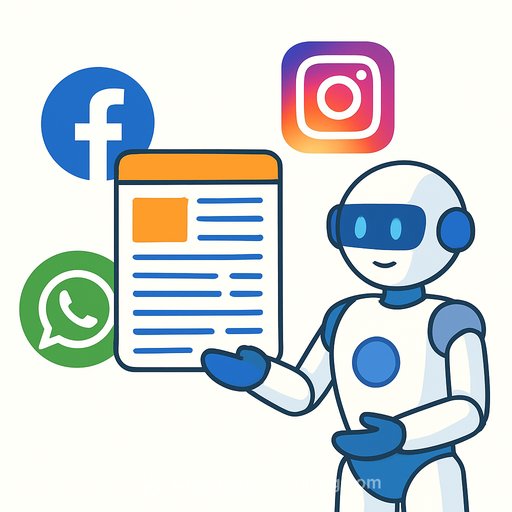AI and Automation: The rise of the cyborg communicator
"The future of AI is not about replacing humans, it's about augmenting human capabilities." - Sundar Pichai, CEO of Google
AI has moved faster than any tool since the early internet. In two years, it has reshaped daily work and forced comms teams to answer a simple question: how do we use this to tell better stories and earn more trust?
The answer: become a cyborg communicator - part human, part AI - and redirect the saved hours into higher-level counsel, sharper strategy, and outcomes the business feels.
From human to cyborg
Generative AI became mainstream almost overnight. ChatGPT reportedly hit 100 million users in two months, the fastest rise on record at the time source. Agents now draft emails, shop, and trigger workflows off a single prompt. Media teams use it for reader engagement, text-to-audio, and first-draft support.
Communicators can't lag. AI should sit beside you as a brainstorming partner, second set of eyes, and data analyst. With the right inputs and guardrails, it becomes a teammate that compresses time and expands your surface area of insight.
What "cyborg" looks like in practice
- Briefing co-pilot: summarize complex topics, extract angles, and stress test messages before you pitch.
- Pitch optimizer: tailor a draft to a reporter's beat, voice, and past coverage while you handle the relationship.
- Signal scanner: track sentiment, themes, and emerging narratives across media and social in minutes, not days.
- Measurement engine: connect earned media to site actions, leads, or even market signals for executive-ready views.
Consider a large enterprise comms team that built internal tools through "vibe coding" - lightweight, rapid experiments to solve real PR jobs. One dashboard tied earned coverage patterns to stock movement, reframing comms from cost center to revenue-adjacent insight. Faster reads. Clearer attribution. More credibility at the table.
How to start augmenting your skills
Drop the old stereotype that AI replaces you. In many teams, it's now expected you use it for day-to-day work. The advantage goes to the pros who set rules, test use cases, and build small automations that compound.
Step 1: Align on policy and ethics
- Read your company's AI policy. About half of organizations report having one source.
- Decide what data is safe to use. Keep confidential information out of public tools unless your legal team approves.
- Label AI-assisted work where appropriate. Protect trust. Protect the brand.
Step 2: Train your co-pilot on context
- Feed past press releases, pitches, message houses, FAQs, and style guides.
- Add audience profiles and reporter preferences. The more context, the better the feedback.
- Ask for critiques, not just drafts. "Where is this weak? What will a skeptical editor push back on?"
Step 3: Use AI daily on low-risk tasks
- Outline first. Draft second. Human edit last.
- Run a "second read" for clarity, jargon, and passive voice. Then you decide.
- Brainstorm 10 angles, three headlines, and two subject lines per pitch. Keep the best. Trash the rest.
Step 4: Build small agents that save big time
- Monitoring agent: pull daily coverage, summarize sentiment, flag risks, and populate a team brief.
- Reporter prep agent: compile recent articles, preferred topics, and suggested hooks before outreach.
- Content QA agent: check claims for citations, dates, and named sources; flag anything that needs fact-checking.
Step 5: Measure like a strategist
- Content: time saved per asset, revision cycles, and message consistency.
- Media: placements, quality score (tier, relevance, quote depth), and share of voice vs. competitors.
- Business: site traffic from earned coverage, newsletter signups, demo requests, or market indicators.
Prompts that actually work
- "Act as a senior tech reporter at [Outlet]. I'll paste a pitch draft. Score it for newsworthiness (0-10), clarity, and proof. Suggest 3 stronger angles with one data point each."
- "Turn this press release into a 150-word internal post for employees in non-technical roles. Keep tone: clear, confident, no hype. Add one quote and one specific example."
- "Summarize these 12 articles into a brief: themes, sentiment, recurring sources, and what we should say or avoid next week."
Guardrails that keep trust intact
- Assume hallucinations can happen. Verify names, dates, links, and numbers.
- Never outsource judgment. AI proposes; you dispose.
- Keep a human-in-the-loop for anything public-facing.
- Document prompts and decisions so results are repeatable and auditable.
Fear of the AI takeover
"Will AI replace our jobs?" Fair question. We're still far from artificial general intelligence. The real risk is dulling critical thinking by accepting machine output without a challenge.
Communicators are trained to question everything. Keep that muscle strong. As Ginni Rometty put it: "AI will not replace humans, but those who use AI will replace those who don't." Start small - outlines, second reads, brainstorming - and build from there.
Level up your capability stack
- Block weekly time to test one use case and ship one tiny improvement.
- Create a shared prompt library for your team. Keep what works. Kill what doesn't.
- Partner with data and engineering for simple dashboards that connect coverage to outcomes.
- Invest in training so your team speaks the same language and moves faster together.
If you want structured upskilling by role, explore curated courses for comms and marketing teams here: Complete AI Training - Courses by Job.
The bottom line
AI won't steal your craft. It will expose your process. The pros who combine taste, judgment, and automation will outpace those who don't.
Become the cyborg communicator: keep the human instincts that build trust, add the systems that compound results, and claim a true seat at the strategy table.
Disclosure
In the spirit of being a cyborg communicator, AI helped build an outline for this story and provided feedback on structure and flow. AI did not write any of the content.
Your membership also unlocks:






